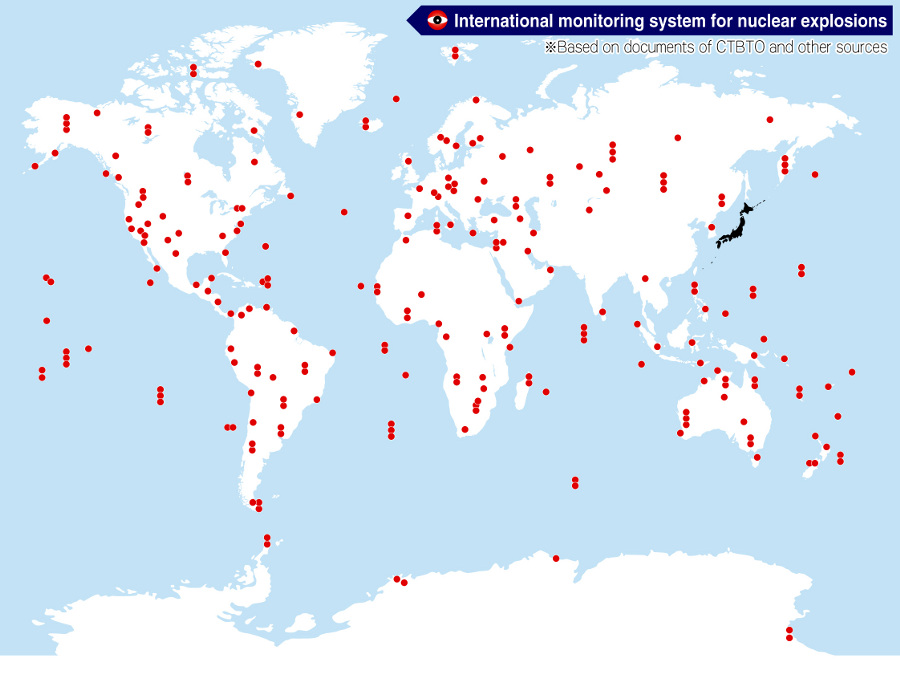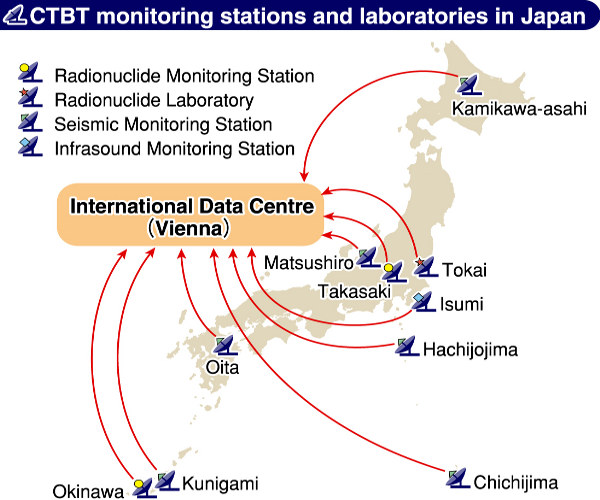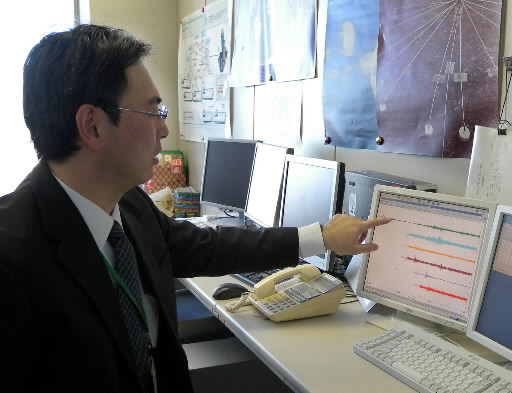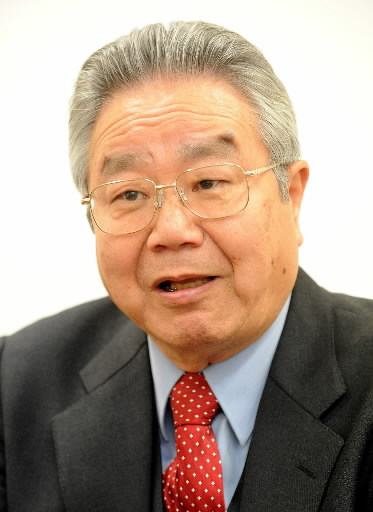Nuclear weapons can be eliminated: Special Series, Part 9
Jan. 26, 2010
Special Series: The Day the Nuclear Umbrella is Folded
Part 9: A-bombed nation contributes to creation of monitoring network for non-proliferation
by the "Nuclear Weapons Can Be Eliminated" Reporting Team
The abolition of nuclear weapons will only be a realistic possibility when a series of concrete actions by the world's nations with regard to nuclear non-proliferation are fulfilled. Even though the total number of nuclear warheads has been slashed since the height of the Cold War, if further nuclear weapon states emerge, it will become all the more difficult to eliminate nuclear arms from the earth.
In the non-proliferation field, Japan has continued to monitor nuclear testing with its strengths of science and technology. In addition, at the end of 2009, Yukiya Amano, a Japanese national who had served as a senior official in Japan's Ministry of Foreign Affairs, assumed the leadership of the International Atomic Energy Agency (IAEA), the so-called "nuclear watchdog." How can the state-of-the-art technology of the A-bombed nation contribute to preventing nuclear proliferation?
From the 54th floor of the high-rise building in Tokyo called "Sunshine 60," a panoramic view of the city can be seen. Located on this floor is the Japan Weather Association (JWA), which is engaged in the forecasting of weather but also serves as a monitoring base for nuclear testing.
In a room with maps of the world and North Korea posted on the walls, a computer displayed a delicate waveform on its monitor. Takayuki Otsu, a JWA specialist, explained, "This is the seismic waveform that was produced in the wake of the nuclear test conducted by North Korea in May of last year."
Since 2002, the JWA has been commissioned by Japan's Ministry of Foreign Affairs to develop and operate six seismology observatories in a variety of places in Japan, including Matsushiro, Nagano City, as well as an observatory in Isumi City, Chiba Prefecture. This observatory is a special facility that can detect vibrations in the air in the wake of a nuclear explosion. Thus, the JWA plays a part in the global network for monitoring nuclear explosions, a network established as a product of the Comprehensive Test Ban Treaty (CTBT). Data obtained by the JWA is sent to the International Data Center at the Comprehensive Nuclear-Test-Ban Treaty Organization (CTBTO) headquartered in Vienna. At the same time, the JWA also receives data from around the world, through the CTBTO, for analysis.
In addition to the JWA, two other organizations in Japan are keeping watch on the world: The Japan Atomic Energy Agency in Tokaimura, Ibaraki Prefecture observes and analyzes radioactive materials from dusts and gasses in the air and the Center for the Promotion of Disarmament and Non-Proliferation at the Japan Institute of International Affairs is engaged in mostly administrative duties.
Yoshitaka Yokoyama, director-general of the Center's planning department, stated: "Japan's advanced technology used to analyze epicenters and the magnitude of earthquakes is being utilized to detect nuclear explosions. Its capacity to analyze data with regard to the collected radioactive materials has also been valued highly."
Although the effectuation of the CTBT is not yet in sight, as many as 250 facilities are in operation worldwide to form a monitoring network on a global scale to detect nuclear explosions. "The awareness that all nuclear explosions will surely be detected will deter nuclear tests from occurring," said Mr. Yokoyama.
On the other hand, Nobuo Arai, a JWA official, pointed out the challenges facing their work. "Although Japan is a world leader in terms of seismic research," he said, "only a relative handful of people in Japan show interest in nuclear testing and disarmament. As the A-bombed nation, we have too few human resources."
Meanwhile, there has been a new development at the IAEA, headquartered in Vienna. In December 2009, Yukiya Amano became director general of the organization, which is charged with promoting the peaceful use of nuclear energy and preventing materials for the purpose of nuclear energy from being converted to military use. Tsutomu Koizumi, director of the Non-Proliferation, Science and Nuclear Energy Division at the Ministry of Foreign Affairs, stressed the significance of Mr. Amano assuming the office, and said, "As the A-bombed nation, Japan can provide further contributions in the field of nuclear non-proliferation and the peaceful use of nuclear energy, which serves as one of the three pillars of the Nuclear Non-proliferation Treaty (NPT).”
In September 2009, the UN Security Council Summit adopted a resolution aimed at achieving "a world without nuclear weapons." In this resolution a provision was included which urges all nations to embrace an additional protocol developed by the IAEA for strengthening its inspection system. A strong appeal on the part of Japan was reportedly behind the move.
Furthermore, when Japanese Prime Minister Yukio Hatoyama visited India, he strongly urged Manmohan Singh, the Indian prime minister, to sign the CTBT. To his request, Mr. Singh responded, "If both the United States and China ratify the treaty, a new situation will arise." As long as the CTBT is stalled from taking effect, the on-site inspection system, which is expected to be an effective tool for curtailing nuclear testing, like the network that monitors nuclear explosions, will not be implemented.
India is not the only nation impeding progress. Pakistan and North Korea have not signed the CTBT and the United States and China have yet to ratify the treaty. Major focal points over reinforcing the nuclear non-proliferation system this year are whether the U.S. administration can move forward with ratification of the CTBT, as President Obama desires, and whether diplomatic efforts by the A-bombed nation of Japan can contribute to paving the way toward this ratification by the United States.
Model Additional Protocol
The IAEA crafted the "Model Additional Protocol" to reinforce its conventional inspection treaty at the IAEA board meeting held in 1997. This protocol was prompted by the discovery of nuclear development programs in Iraq and North Korea, despite the fact that both nations had received inspections by the IAEA. The protocol adds private research institutes and other facilities as sites that must be declared for inspection, along with the nuclear power plants and other places where nuclear materials exist. Moreover, the protocol stipulates the strengthened authority of the inspectors to visit even undeclared sites for inspection.
To date, 94 countries, including Japan, have concluded the additional protocol with the IAEA. Acknowledged as a nation "which shows no signs of converting nuclear energy to military use," for this and other reasons, since 2004 Japan has been placed into the category of "Integrated Safeguards System" under which efficient inspections are conducted.
Japan's role in international society: An interview with Hiroshi Tani
The Chugoku Shimbun interviewed Hiroshi Tani, 68, an expert on nuclear non-proliferation and former head of the inspection information processing division of the IAEA, on Japan's role in international society. Below are his profile and his thoughts.
Hiroshi Tani
Mr. Tani was born in Tokushima Prefecture in 1941. After serving as assistant director of the Nuclear Safety Bureau of the Science and Technology Agency, he was involved in the development of the nuclear explosion detection system as head of the IAEA division for inspection information processing. He also served as executive director of the Japan Atomic Energy Research Institute, which is now known as the Japan Atomic Energy Agency.
Japan provides an example for the international community
The pillar of Japan's nuclear policy is the Atomic Energy Basic Law, which stipulates that nuclear energy must be used for peaceful purposes and transparency must be ensured through disclosure of information. In addition to its cooperation with the IAEA, the nation has demonstrated through its behavior that, even though it has the technical capacity to develop nuclear weapons, it will not divert its technology to military use.
In fact, IAEA inspectors rate Japan's attitude very favorably. This attitude, which provides a positive example for other countries in the world, is very different from those of North Korea and Iran, whose nuclear ambitions present problems.
Nuclear furnaces and fuel used in Japan are unsuitable for nuclear development. Nuclear fuel is precisely measured, strictly controlled and correctly reported.
Model Additional Protocol should be signed by all signatories
When I took a post at the IAEA in 1992 right after the Gulf War, Iraq was at the center of a large problem because it was secretly developing nuclear weapons despite inspections by the IAEA. So, the following year, we began reviewing the inspection procedure before the NPT Review Conference scheduled for 1995. This process proved fruitful in the form of the Model Additional Protocol.
Reflecting on Iraq and such concerns, it is of vital importance that all NPT signatories approve the additional protocol. Japan, in addition to observing the rules, has been displaying the initiative in urging other states to sign the protocol.
The fact that Yukiya Amano was chosen head of the IAEA demonstrates the international community's trust of Japan. But Mr. Amano's role is not a representative for Japan but an international civil servant. The kind of contribution Japan should make involves offering support for Mr. Amano so he can provide the full scope of his ability in a fair and independent way.
In seeking to be a sailor, I attended the Japan Coast Guard Academy. I worked at the 6th Regional Coast Guard Headquarters in Hiroshima for six months in 1963. At that time, I lived in Minami-machi [in Minami Ward, Hiroshima] and there were A-bomb survivors living in my neighborhood. I am well aware that I am from an A-bombed country.
But while I was working for the IAEA, which is an international organization, I had some thought-provoking experiences. When I spoke with Hans Blix, then director general, and Mohamed ElBaradei, then head of External Relations and Policy Coordination, I told them that Japan should be trusted since it had experienced the A-bomb attacks. They responded that this sort of trust is not enough.
Down-to-earth efforts will win real confidence
Trust is only emotional confidence. We should continue making down-to-earth efforts to win real confidence. That is the course Japan should take. We cannot earn the confidence that we will not use our technology for military use simply because we experienced the atomic bombings. The road to nuclear disarmament and nuclear non-proliferation will be long and hard. A strong will is required to continue making efforts and attain this goal.
In the resolution seeking the elimination of nuclear weapons, which was proposed last year by Japan at the United Nations General Assembly and adopted overwhelmingly, the United States became a co-sponsor for the first time. With the involvement of the world's largest nuclear power, the resolution will surely provide momentum for the NPT Review Conference scheduled for this coming May.
(Originally published on January 17, 2010)
To comment on this article, please click the link below. Comments will be moderated and posted in a timely fashion. Comments may also appear in the Chugoku Shimbun newspaper.










